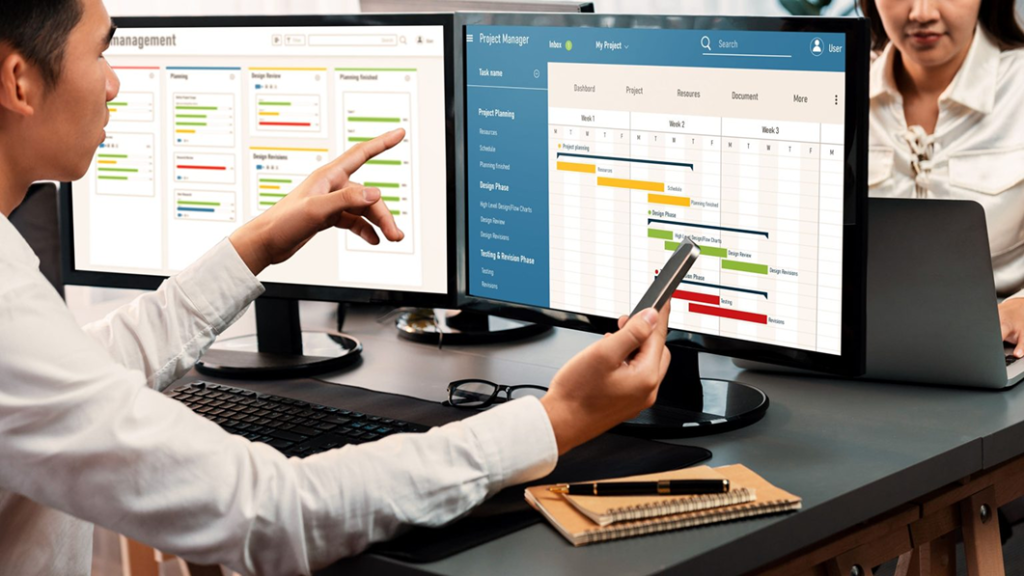
How Task Management Software Transforms Small Business Operations
When you first start a business, instinct and simple tools are often enough. A spreadsheet helps you plan, sticky notes remind you of tasks, and WhatsApp keeps quick conversations going with your team. That works, for a while.
But as your business grows, the cracks start to appear. New team members join. Clients call more frequently. The number of tasks multiplies. Suddenly, no one is sure who owns which responsibility. Deadlines slip, tasks are forgotten, and employees end up duplicating the same work. Messages get buried in endless chat threads, and there is no single source of truth. This uncertainty creates confusion, drains energy, and wastes valuable time that could be spent moving the business forward.
Understanding The Role of Task Management Software in Modern Businesses
At the core, every business runs on tasks. Every strategic goal, whether launching a product, serving a client, or closing a sale, gets broken down into small, actionable items called tasks. On any given day, businesses may juggle dozens or even hundreds of such tasks.
“Task management provides a system for organizing this workload, making it clear what needs to be done, by whom, and by when. It ensures the right people focus on the right work at the right time.”
As businesses grow, projects become more complex, and the number of tasks rises. Managing them manually soon leads to chaos. A sales manager may miss a client follow-up buried in an email, a marketing team might duplicate a campaign due to unclear ownership, or a product team could delay a launch because task dependencies weren’t visible.
A centralized task management platform solves these issues by consolidating tasks, updates, and communication in one place. This eliminates scattered systems and creates clarity. According to the latest research, the global Task Management Software Market is set to grow from USD 3.25 billion in 2024 to USD 11.94 billion by 2034, at a 13.90% CAGR, reflecting the rising demand for structured task management worldwide.
What is Task Management Sofware?
Task management software is a digital system designed to create, assign, track, and organize tasks within a business workflow. It centralizes work items, deadlines, dependencies, and resource allocation, enabling teams to manage both individual and collaborative responsibilities in a structured manner.
Unlike general productivity tools, task management software is purpose-built for operational control, ensuring visibility, accountability, and scalability in project execution.
A good task management software provides:
- Task creation and assignment with ownership, due dates, and priority levels.
- Workflow organization through lists, boards, timelines, or Gantt charts.
- Progress tracking with real-time status updates and completion metrics.
- Collaboration features such as comments, file attachments, and notifications.
- Automation capabilities to handle recurring tasks, reminders, and approvals.
Reporting and analytics for performance monitoring and workload distribution.
Task management software serves as the foundation for structured productivity. By providing a real-time view of what’s happening, who’s doing what, and when it’s due, task management software eliminates the guesswork that often clutters everyday operations.
Key Ways Task Management Software Improves Small Business Efficiency
1. Streamlining Task Tracking for Better Accountability
Visibility is the foundation of effective task management. With the right software, every team member knows what to do, when it’s due, and who to work with. Business owners gain real-time insight into project status, pending deliverables, and potential roadblocks.
Tasks are no longer hidden in sticky notes or buried in emails. Instead, they are trackable, auditable, and clearly documented across the team. This transparency fosters accountability, reduces duplication of work, and makes progress easier to evaluate.
2. Enhancing Productivity with Centralized Tools
Small businesses often lose time to constant context switching. Teams jump between emails, spreadsheets, and chat apps just to manage daily tasks. Task management software consolidates these functions into a single platform. Documents and messages can be attached directly to tasks, creating one central source of truth. Teammates can tag each other for quick input or feedback.
Shared boards and calendars help teams track workflows in real time. With everything stored in one place, employees save time and maintain focus. This integration reduces information overload and allows people to get more done with less effort.
3. Prioritizing Tasks to Focus on What Matters Most
When everything feels urgent, knowing where to start becomes difficult. Task management tools bring clarity by introducing priority settings, color codes, or tags. Teams can filter work by urgency, deadlines, or strategic importance.
Dashboards highlight top-priority actions, ensuring critical tasks receive attention first. Instead of reacting to constant pings or scattered emails, employees structure their days intentionally. This shift moves work from reactive habits to focused execution. The result is higher productivity, reduced stress, and a stronger sense of control.
4. Improving Workflow Organization Across Teams
Disorganized task assignments often create confusion, missed steps, and delays. Task management software turns messy workflows into structured, repeatable processes. Each task links to a larger project, assigned to the right person at the right stage.
For example, client onboarding may involve ten repeatable steps across different departments. Templates standardize these steps so every client receives the same experience. Status indicators show progress clearly, allowing teams to track completion in real time. This structure minimizes miscommunication and ensures smooth handoffs from start to finish.
5. Simplifying Project Tasks and Milestone Tracking
Large initiatives contain multiple layers of interconnected tasks. Without structure, deadlines slip and bottlenecks go unnoticed. Task management platforms allow teams to break projects into smaller sub-tasks. Dependencies can be mapped, milestones can be tracked, and progress can be visualized. Teams monitor timelines, adjust workloads, and identify risks before they escalate.
Milestone tracking also helps leaders see how daily work connects to larger goals. Even as team dynamics shift or workloads fluctuate, projects stay aligned. This clarity keeps initiatives on track and reduces last-minute stress.
Impact of Task Management Software on Team Collaboration and Communication

Breaking Down Silos and Encouraging Transparency
Small teams often face misalignment due to fragmented tools and scattered information. Task management software eliminates this problem by creating a shared space where tasks, updates, and conversations come together. Every team member can see the full scope of a project and understand how their work connects with others. Dependencies between tasks become visible, ensuring no step is overlooked.
With documents, notes, and updates stored in one place, everyone works with the same information. This shared visibility reduces misunderstandings and builds trust across departments, fostering a culture of collaboration.
Facilitating Remote Work and Distributed Teams
Remote work has become a permanent reality for many businesses. In fact, by 2030, remote jobs are estimated to grow by around 25% to over 90 million roles. But, on the ground level, distance often leads to confusion and missed details without a clear system. Task management software addresses this challenge by mimicking the clarity of in-person collaboration through digital tools.
Teams gain access to asynchronous communication, shared timelines, and documented task histories. Whether employees are in different cities or time zones, they can update task status at any time, leave comments, and tag teammates for quick input. Project progress is visible without waiting for live meetings, which keeps work moving smoothly. This flexibility ensures productivity stays consistent even when teams are apart.
Real-time Updates and Notifications for Seamless Coordination
Task management systems also improve coordination with real-time notifications. The moment a task is updated, completed, or reassigned, the right people are alerted instantly. Managers no longer need to chase updates or wonder about progress.
Alerts prompt timely follow-ups, allowing leaders to intervene before delays escalate. Team members stay aligned without constant reminders or micromanagement. This flow of instant communication creates accountability while reducing friction, ensuring projects advance on schedule.
Selecting the Right Task Management Software for Your Small Business
Choosing the right task management software is more than just picking a tool; it’s about finding a system that supports how your team works today and how it will grow tomorrow.
Small businesses often face unique challenges: limited resources, lean teams, and the constant need to balance priorities. The right platform should reduce complexity, not add to it.
Key Features to Look For
Every business needs a foundation of clarity, accountability, and collaboration. Task management software should provide features that simplify daily operations while giving visibility to leaders.
When choosing a task management platform, look for features that support clarity, automation, and collaboration:
- Task assignment with deadlines
- Project boards and calendar views
- Document and file attachments
- Custom labels or tags
- Templates for repeatable workflows
- Time tracking or effort estimation
These core capabilities should align with your team’s size, working style, and growth plans.
Integrations with Existing Business Tools
Small businesses rarely operate with one system alone. Teams use email, chat apps, cloud storage, CRMs, and accounting platforms every day.
The best task management systems don’t replace your current tools; they enhance them. Look for software that integrates with tools like Google Workspace, Slack, email, cloud storage, CRMs, and accounting platforms.
Instead of switching between multiple apps, employees can manage everything from a single platform.This ensures that information flows seamlessly, and your team doesn’t have to constantly switch apps to complete a task.
Scalability and Customization Options
Your business today may not look the same in a year. Choose a platform that grows with you. Whether it’s adding more users, managing more complex projects, or automating additional workflows, your task management software should offer flexibility.
Customization options, like personalized dashboards, access permissions, and automation rules, ensure the system fits your specific needs, rather than forcing you to adapt to rigid structures.
Wispa is Designed for Small Businesses Ready to Grow
Most task management tools fall into two extremes. Either they are too simple to be useful or too complex for small businesses to adopt easily. Wispa was built to bridge this gap. It offers an intelligent, user-friendly approach that supports both lean teams and growing companies.
Here’s what makes Wispa work so well:
- Visual Workflows: Drag-and-drop boards, clear status updates, and color-coded stages help you see the big picture at a glance.
- Role-Based Assignment: Tasks are clearly distributed across roles, with due dates, dependencies, and checklists built in.
- Centralized Communication: Chat, comments, and documents live within each task—no more hopping between apps.
- Automation & Templates: Set up recurring tasks, approvals, reminders, and follow-ups once and reuse them effortlessly.
- Real-Time Dashboards: Know who’s working on what, which projects are delayed, and where the team’s time is going.
- Scalable System: Whether you’re onboarding your 3rd hire or managing a 15-person team, Wispa scales with your growth.
Wispa transforms the way small businesses work by creating clarity, reducing friction, and enabling growth.
Final Thoughts
Small businesses don’t fail because they lack vision. They fail because they lack systems. When tasks are tracked, workflows are defined, and communication is centralized, small businesses reclaim their most valuable asset, i.e., time, which they can utilize in growth.
If your business is ready to move from firefighting to flow, from hustle to harmony, Wispa might be the right choice for you.
Try it today and experience the shift from managing chaos to building clarity.
FAQs
What is task management software and how does it help small businesses?
Task management software enables small businesses to organize, assign, and track tasks efficiently, reducing confusion, improving accountability, and streamlining workflows for better productivity.
How does task management software improve team collaboration?
It fosters collaboration through shared dashboards, real-time updates, and integrated communication tools, ensuring teams stay aligned, accountable, and focused on shared goals without constant back-and-forth.
Can task management software help with project management?
Yes. Most platforms include project management features such as milestone tracking, timeline visualization, and reminders, helping businesses monitor progress and ensure projects stay on track.
What are essential features of effective task management software?
Effective platforms include task assignment, priority settings, deadline tracking, progress visibility, collaboration features, and seamless integrations with tools like email, calendars, or cloud storage.
Is task management software suitable for remote teams?
Absolutely. Remote teams benefit from centralized platforms where tasks, updates, and communication remain accessible anytime, fostering transparency, consistency, and productivity across different locations and time zones.
Frequently Asked Questions
Task management software enables small businesses to organize, assign, and track tasks efficiently, reducing confusion, improving accountability, and streamlining workflows for better productivity.




